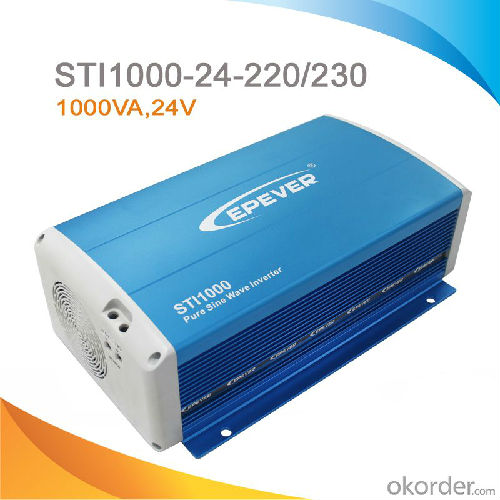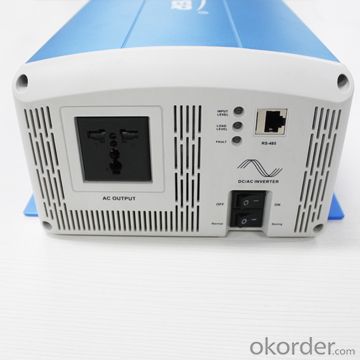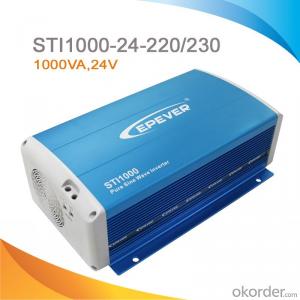STI 1000W Frequency Pure Sine Wave Inverter DC 24V to AC 220V/230V,STI1000
- Loading Port:
- China Main Port
- Payment Terms:
- TT or LC
- Min Order Qty:
- -
- Supply Capability:
- -
OKorder Service Pledge
OKorder Financial Service
You Might Also Like
Description
STI series is a sine wave power frequency inverter which can convert 12V or 24V DC to 220VAC or 230VAC 50Hz based on full digital and intelligent design. The inverter can be applied in many fields especially for solar photovoltaic power system.

Features:
·Complete isolation-type inverter technology, noiseless output
·Adoption of advanced SPWM technology, pure sine wave output
·Dynamic current loop control technology to ensure inverter reliable operation.
·Wide DC input voltage range
·Excellent EMC design
·Low output harmonic distortion(THD≤3%)
·LED indicators display input voltage range, load power range, normal output & failure state
·Optional energy saving mode
·Wide working temperature range (industrial level)
·Continuous operation at full power
Protections:
·Output Short Circuit protection
·Overload protection
·Input reverse polarity protection
·Input low voltage protection
·Input over voltage protection
·Inverter abnormal protection
·Overheating protection


Specification:
Types | SHI1000-22 | SHI1000-42 |
Nominal Battery Voltage | 24V | 48V |
Input Voltage Range | 21.6~32Vdc | 43.2~64Vdc |
No Load Current | ≤0.45A | ≤0.35A |
Output Wave | Pure Sine Wave | |
Output Voltage | 220Vac±3% / 230Vac±10% | |
Continuous Power | 1000W | |
Power 10 sec | 1500W | |
Power 1.5 sec | 2000W | |
Surge Power | 2250W | |
Frequency | 50/60Hz±0.2% | |
Distortion THD | ≤ 3% (resistive load) | |
Efficiency at Rated Power | ≥93% | ≥93.5% |
Max. Efficiency | ≥94% | ≥94% |
Terminal | 25mm2 | |
Dimensions | 295×208×98mm | |
Installation | 150×200mm | |
Hole Size | Φ6mm | |
Net Weight | 3.3kg | |
Working Temperature | -20℃~ +50℃ | |
Storage Temperature | -35℃~ +70℃ | |
Humidity | < 95% (N.C.) | |
Altitude | < 5000m(Derating to operate according to IEC62040 at a height exceeding 1000m) | |
Insulation Resistance | Between DC input terminals and metal case: ≥550MΩ; Between AC output terminals and metal case: ≥550MΩ. | |
Dielectric Strength | Between DC input terminals and metal case: Test voltage AC1500V, 1 minute Between AC output terminals and metal case: Test voltage AC1500V, 1 minute | |
FAQ
Central inverter and String inverter Comparison
In terms of money, string inverters will get more and more expensive vs central inverters as the field size increases. It's a heck of a lot of additional labor to hook up 100 string inverters of 10kW vs. 3 or 4 central inverters (which can also be bought in pre-configured 1MW units with some of the connections already done).
Personally, I would draw the line around 250 - 400 kW. Below that string inverters work out well. Above that central inverters have their place (and will save money). Can it be made to work either way, and work well? Sure!
- Q:Can a solar inverter be used in regions with high levels of lightning activity?
- Yes, a solar inverter can be used in regions with high levels of lightning activity. However, it is important to install appropriate lightning protection measures to ensure the safety and functionality of the solar inverter system. This can include surge protection devices and grounding systems to mitigate potential damage caused by lightning strikes.
- Q:Can a solar inverter be used in a multi-string configuration?
- Yes, a solar inverter can be used in a multi-string configuration. A multi-string configuration refers to connecting multiple strings of solar panels to a single inverter. This setup allows for better utilization of the inverter's capacity and can accommodate larger solar installations.
- Q:Can a solar inverter be used with a solar-powered desalination system?
- Yes, a solar inverter can be used with a solar-powered desalination system. A solar inverter is needed to convert the direct current (DC) produced by solar panels into alternating current (AC) that can be used to power the desalination system. This allows for the efficient utilization of solar energy in powering the desalination process.
- Q:How does a solar inverter handle different temperature conditions?
- A solar inverter is designed to handle different temperature conditions by employing various thermal management techniques. It typically has built-in cooling systems such as fans or heat sinks to dissipate excess heat. Additionally, advanced inverters may employ temperature sensors to monitor the internal temperature and adjust their operations accordingly. These temperature compensation features allow the inverter to maintain optimal performance and efficiency across a wide range of temperature conditions.
- Q:How is a solar inverter different from a regular inverter?
- A solar inverter is specifically designed to convert the DC (direct current) electricity generated by solar panels into AC (alternating current) electricity suitable for use in homes and businesses. On the other hand, a regular inverter is mainly used to convert DC electricity from batteries or other sources into AC electricity. Therefore, while both inverters convert electricity from one form to another, a solar inverter is tailored for the unique requirements of solar power systems.
- Q:Can a solar inverter be used in areas with high levels of lightning activity?
- Yes, a solar inverter can be used in areas with high levels of lightning activity. However, it is important to ensure proper installation and grounding measures are in place to protect the inverter from potential damage caused by lightning strikes.
- Q:What are the key factors affecting the efficiency of a solar inverter?
- The key factors affecting the efficiency of a solar inverter include the quality and design of the inverter itself, the type and quality of the solar panels used, the temperature at which the inverter operates, and the level of shading or obstruction on the solar panels. Additionally, the efficiency can also be influenced by the electrical load connected to the inverter and the overall system design and installation.
- Q:How the output voltage of the PV inverter and the grid-connected voltage are determined
- supply through the cable to the battery. The use of household appliances connected to the power converter output can be used in the car a variety of electrical appliances. The available electrical appliances are: mobile phones, laptops, digital cameras, cameras, lights, electric razors, CD players, game consoles, handheld computers, power tools, car refrigerators and various tourism, camping, medical emergency appliances Wait.
- Q:What are the indicators of a faulty solar inverter?
- Some indicators of a faulty solar inverter include a complete loss of power generation, inconsistent or fluctuating power output, unusual noises or smells coming from the inverter, error messages or warning lights on the display panel, and physical damage or overheating of the inverter unit.
- Q:What is the maximum current output of a solar inverter?
- The maximum current output of a solar inverter depends on various factors such as its power rating, design, and specifications. Typically, solar inverters have a maximum current output ranging from a few amperes to several hundred amperes, depending on the specific model and capacity.
1. Manufacturer Overview |
|
|---|---|
| Location | |
| Year Established | |
| Annual Output Value | |
| Main Markets | |
| Company Certifications | |
2. Manufacturer Certificates |
|
|---|---|
| a) Certification Name | |
| Range | |
| Reference | |
| Validity Period | |
3. Manufacturer Capability |
|
|---|---|
| a)Trade Capacity | |
| Nearest Port | |
| Export Percentage | |
| No.of Employees in Trade Department | |
| Language Spoken: | |
| b)Factory Information | |
| Factory Size: | |
| No. of Production Lines | |
| Contract Manufacturing | |
| Product Price Range | |
Send your message to us
STI 1000W Frequency Pure Sine Wave Inverter DC 24V to AC 220V/230V,STI1000
- Loading Port:
- China Main Port
- Payment Terms:
- TT or LC
- Min Order Qty:
- -
- Supply Capability:
- -
OKorder Service Pledge
OKorder Financial Service
Similar products
New products
Hot products
Hot Searches
Related keywords































